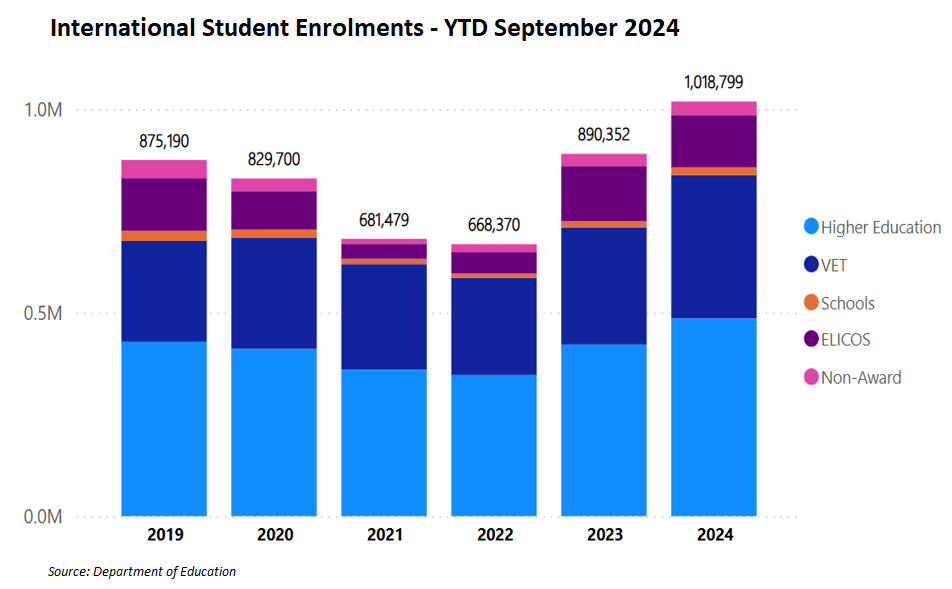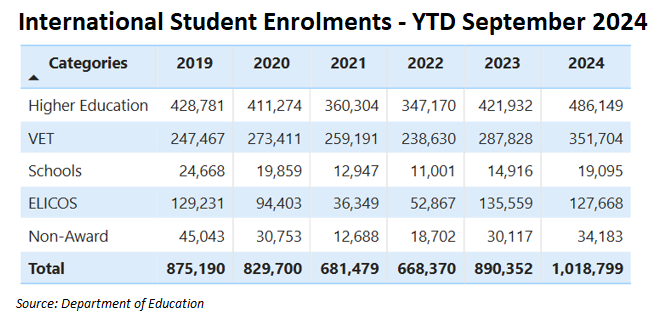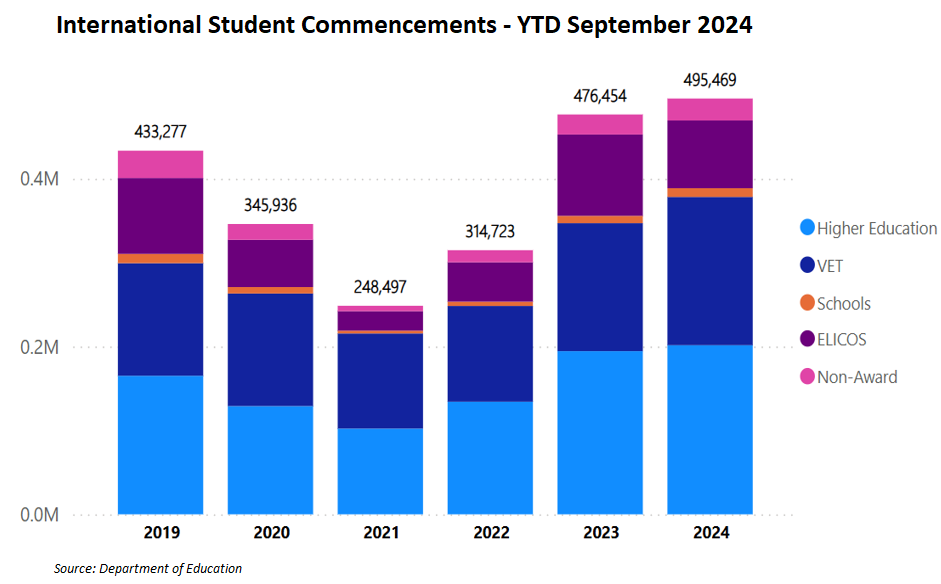New data from the Department of Education shows that international student enrolments surpassed one million for the first time in the year to September 2024.
As illustrated below, there were a record 1,018,799 enrolments in the year to September 2024, up 128,447 from the prior year.

The following table shows that the enrolment surge was driven by universities (higher education), which rose by 64,217, and VET, which increased by 63,876.

Commencements of international students also hit a record high of 495,469 in the year to September 2024, up nearly 20,000 over the year.

Ministerial Direction 107 (MD 107) was introduced by former Home Affairs minister Clare O’Neil one year ago to curb net overseas migration amid the unprecedented surge in international student enrolments following the pandemic.
Under MD 107, immigration officials were required to prioritise the visa applications of students from nations with low rates of visa rejections, such as China.
This meant that applicants from “high-risk” regions, such as South Asia and Africa, that were likely less likely to be genuine students and more likely to overstay their visas, were less likely to be approved.
It also meant that second-tier institutions found it harder to enrol lower-quality students from high-risk nations.
As a result, Australia saw large numbers of Chinese students landing at elite sandstone universities, whereas regional universities saw lower numbers of “high-risk” students arrive.
According to The Australian, “applications from India have fallen by 43% between January and October compared to last year, applications from Nepal dropped by 57%, and those from the Philippines plunged 67%”.
“However, visa applications from China have dipped by less than 2%, with Chinese students typically favouring the Group of Eight universities”.
Second-tier institutions, therefore, strongly lobbied against the repeal of MD 107.
Last week, Education Minister Jason Clare fulfilled their wish by announcing the replacement of MD 107 with MD 111.
Under MD 111, the government will now process visas for all institutions on an equal basis up to 80% of the student cap previously allocated by the government under the failed legislation, also known as their Net Overseas Student Commencement number.
Once an institution has met its 80% allocation, the institution will be moved to the back of the queue, behind other universities that have not yet met their 80% capped number.
Education Minister Jason Clare claimed the new ministerial direction would “strengthen our ability to manage the flow of international students, and better support regional education providers”.
“It shouldn’t just be the big inner-city unis that benefit from international education. TAFEs, regional and suburban unis should benefit too, and this new approach will help us do that”, he said.
The new reforms will, therefore, see lower volumes of higher-quality students arriving at the elite city universities and more lower-quality students arriving at regional universities.
Ultimately, the federal government should be aiming for a much lower quantity of very high-quality, genuine students. This could be achieved via the following types of reforms:
- Significantly increasing English-language standards and requiring prospective students to complete entrance examinations before being permitted to study in Australia.
- Significantly increasing financial requirements, including requiring funds to be paid into an escrow account before arriving in Australia.
- Reducing the number of hours that international students are allowed to work and severing the direct link between study, work, and permanent residency.
- Allowing only top-of-class graduates to receive graduate visas.
- Because Australian universities are non-profit enterprises that do not pay taxes, imposing a levy on international students to ensure that Australians receive a financial return from the trade.
Universities should also be required to provide on-campus housing for international students in proportion to the number of enrolments to reduce pressure on the private rental market.
Instead, Labor has opted for a slightly smaller quantity of lower-quality students.
For this reason, Labor’s international education reforms are a failure.

